In this article I would like to detail the technique of decoupage. Convenient master classes will help to master this craft even for beginners.
Contents
- Decoupage technique for beginners
- Decoupage for tools:
- Decoupage for beginners from napkins: master class
- Decoupage of bottles for beginners
- Decoupage of furniture for beginners
- Decoupage of glass for beginners step by step
- Decoupage for beginners step by step on wood
- Decoupage of casketfor beginners
- Decoupage for beginners watch
- Decoupage of tea houses for beginners
Pleasant on hearing the word "decoupage" immediately brings associations about something refined,rasivom. So it is: the things that touched this art, amaze with their special charm. And, what is most interesting, the technique of decoupage can be mastered absolutely any person. Let's talk about this miracle in this article.
Decoupage technique for beginners
Decoupage technique has its basics , which must be known to beginners:
- You can stick the picture in different ways, but it's best to smooth the from the center to the edges. Bubbles and wrinkles should not be originally
- The glue is recommended in an old, proven way, that is glue PVA .It will keep the drawing very tight
IMPORTANT: Do not try to do everything as quickly as possible - furniture is very important to give a good dry out. And not with a hair dryer, but in a natural way.
- Do not neglect the acrylic paint - so the image does not look foreign, and the thing itself becomes more elegant. Apply paint preferably with a roller
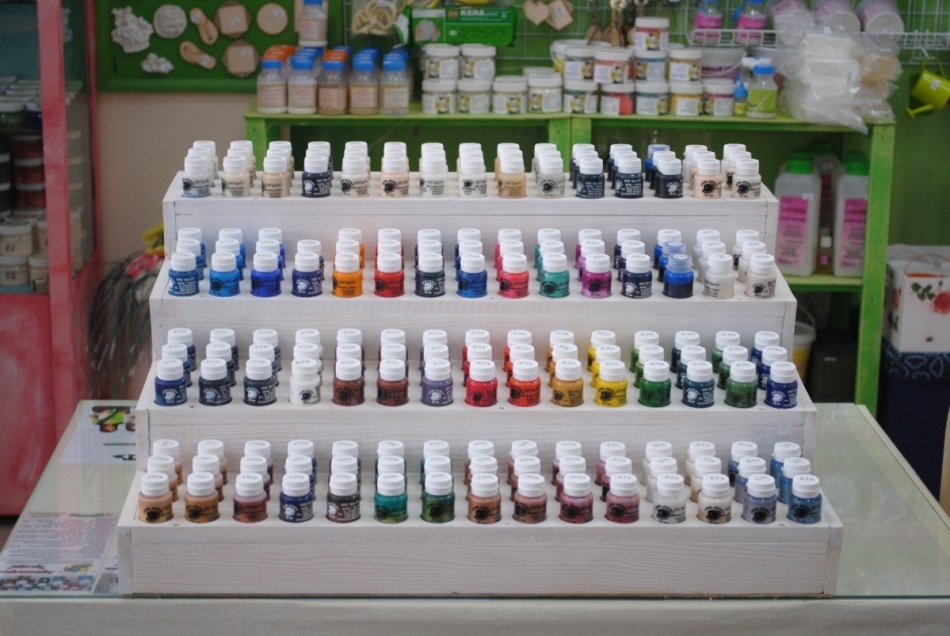 Acrylic paint for decoupage is available in a wide range of shades
Acrylic paint for decoupage is available in a wide range of shades - How many layers of varnish should there be? As a rule, the best results are when layers are two. And before applying the second one, you need to wait until the first
dries. IMPORTANT: The building lacquer will fit, but acrylic is preferred, since it does not smell and does not cause allergies.
- It is useful for beginners to know that acrylic paints and varnishes are washed off with ordinary water within the first 24 hours after the work of .Thus, not entirely successful work can easily be remedied by
- . Whatever the idea, the thing should go through the preparation stage. It includes cleansing as from various kinds of pollution, and from dust.
IMPORTANT: It is advisable to use a solution containing alcohol, but just a damp cloth will do.
As for , there are not many of them:
- Classic - is when the picture is fastened dry, wet or hot, and then it is varnished and then polished. You can also shade the
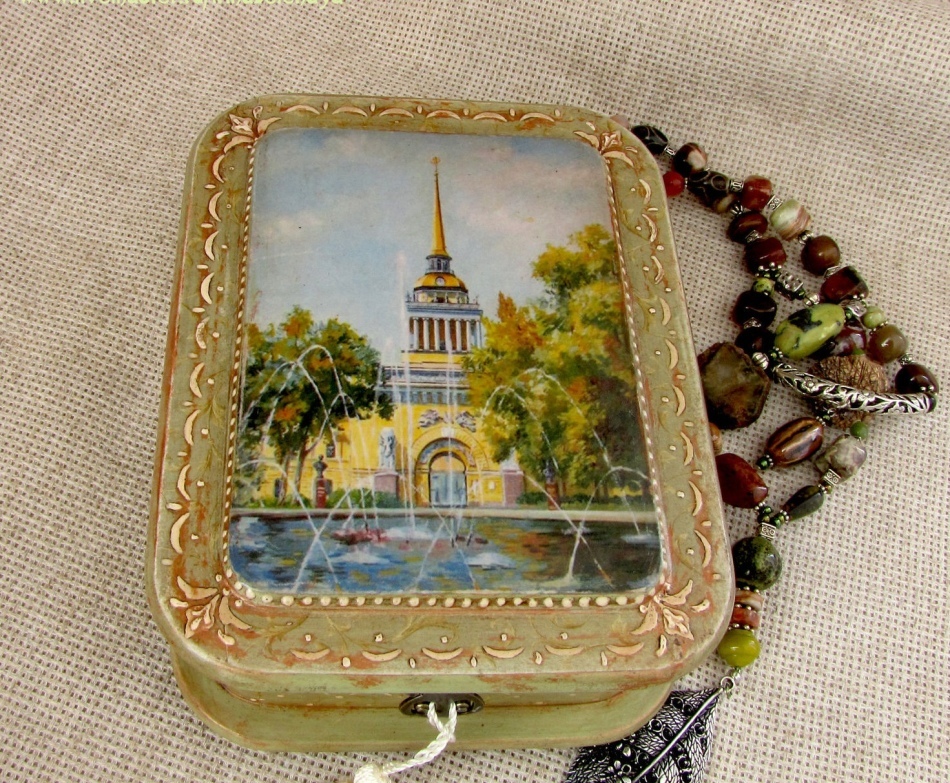 Decoupage of the box according to the classical technique
Decoupage of the box according to the classical technique - Artistic or smoky - looks like a real painting thanks to the successful connection of the picture with the background
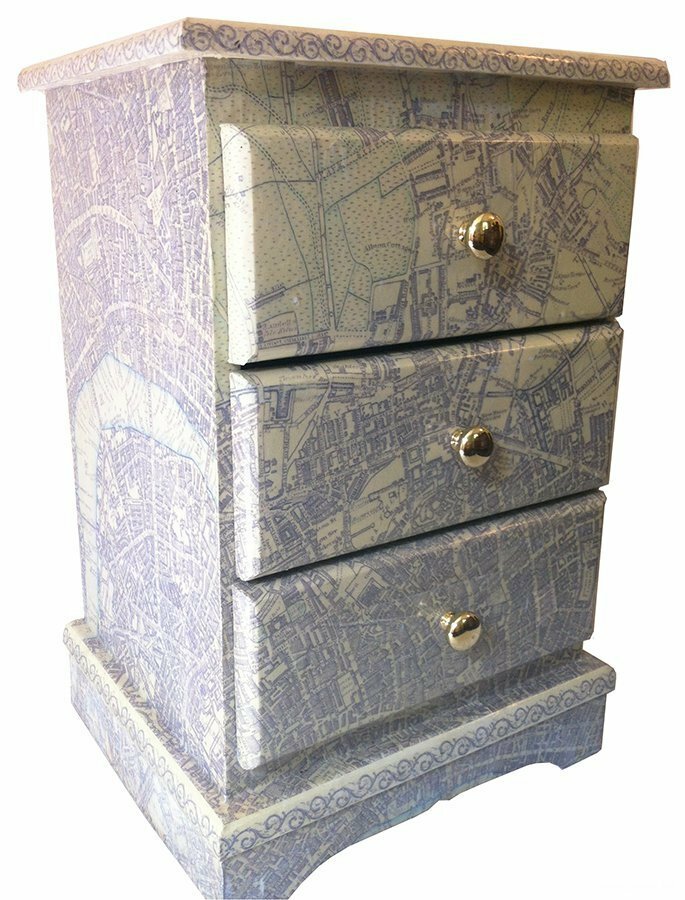 Decoupage of the chest in the smoky technique
Decoupage of the chest in the smoky technique - Reverse - is recommended for processing the transparent surface
- The gluing takes place on the underside of the decorated thing
- Deco-patch or shoebox - simply speaking, is similar to the quilt
IMPORTANT: Deco patch is achieved on any materials, however, beginners are recommendeduse special paper.
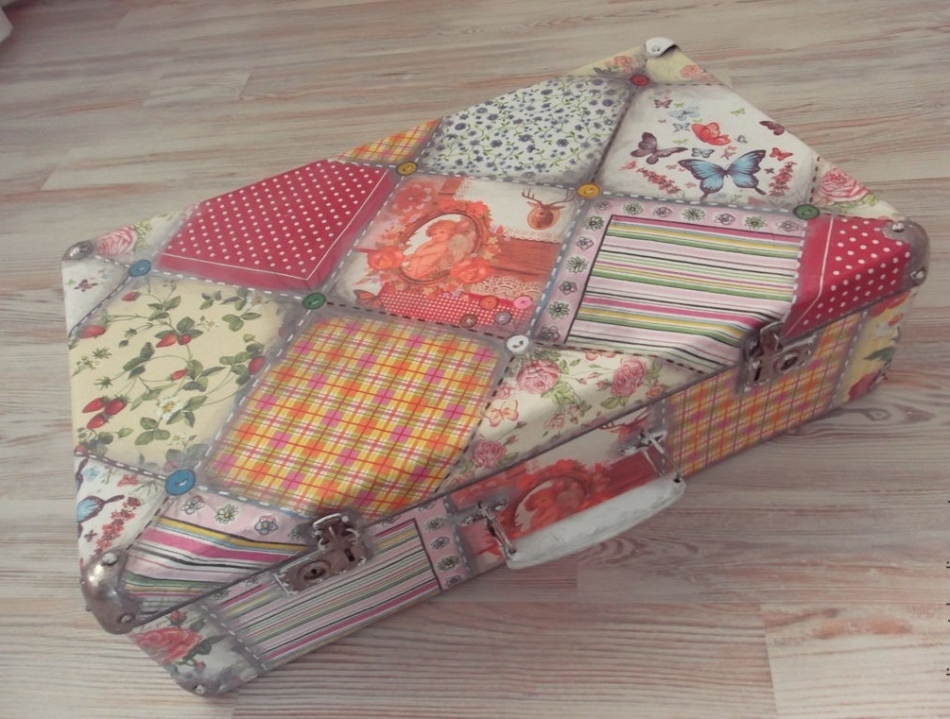 Decoupage of a suitcase in the technique of deco tape
Decoupage of a suitcase in the technique of deco tape - Volumetric - very similar to the relief painting. The so-called structural paste will help in this. Also used material that is very similar to the eggshell
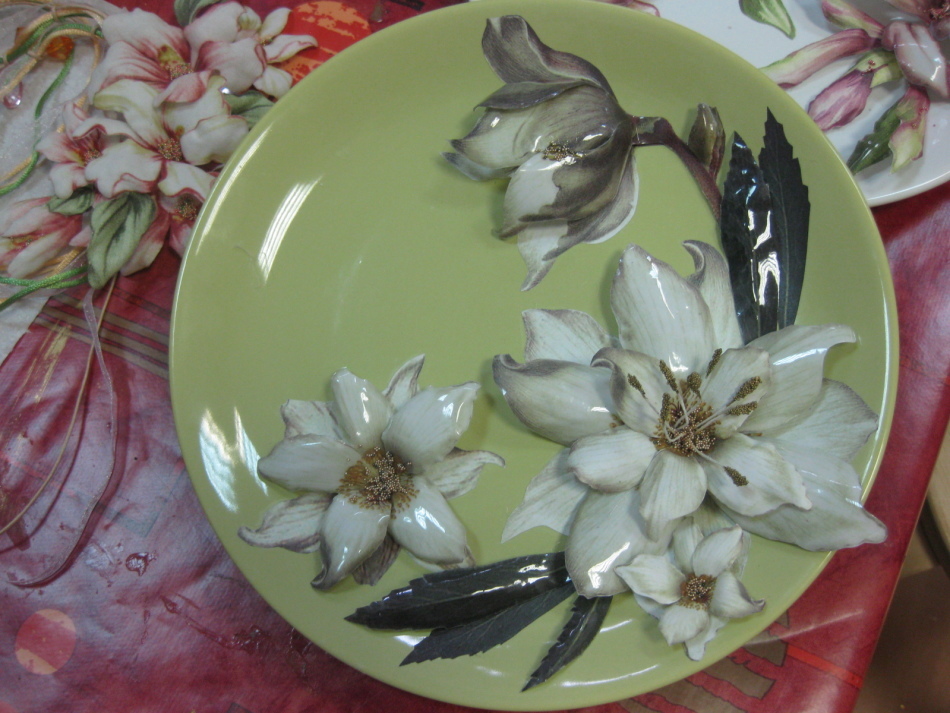 Decoupage plates in the bulk technique
Decoupage plates in the bulk technique What you need for decoupage: tools, materials
First of all, this is the object of decoupage. And they can become anything from furniture to small plates. The surface is allowed any - from wood, glass, fabric, plastic, ceramics, porcelain, metalIMPORTANT: The first steps in decoupage are better to make on wooden surfaces.
- Special wipes for decoupage with images to taste
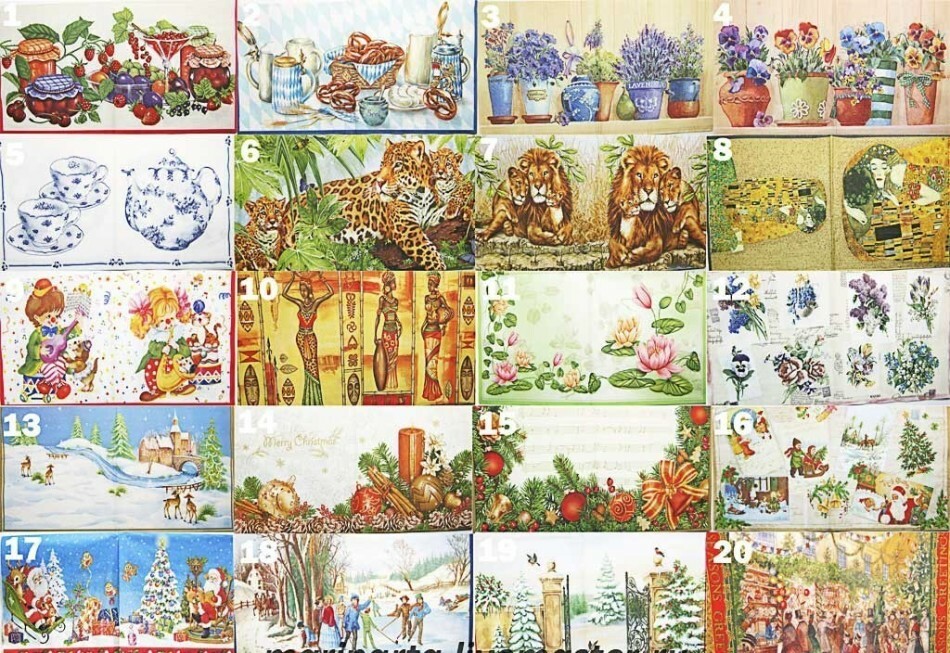 The choice of napkins for decoupage is quite large
The choice of napkins for decoupage is quite large - The cards for decoupage - it's slightly more difficult to work with them than with napkins, but the paint on such cards is of good quality. Beginners are advised to purchase cards on rice paper - they are thin and strong, they do not stretch when working.
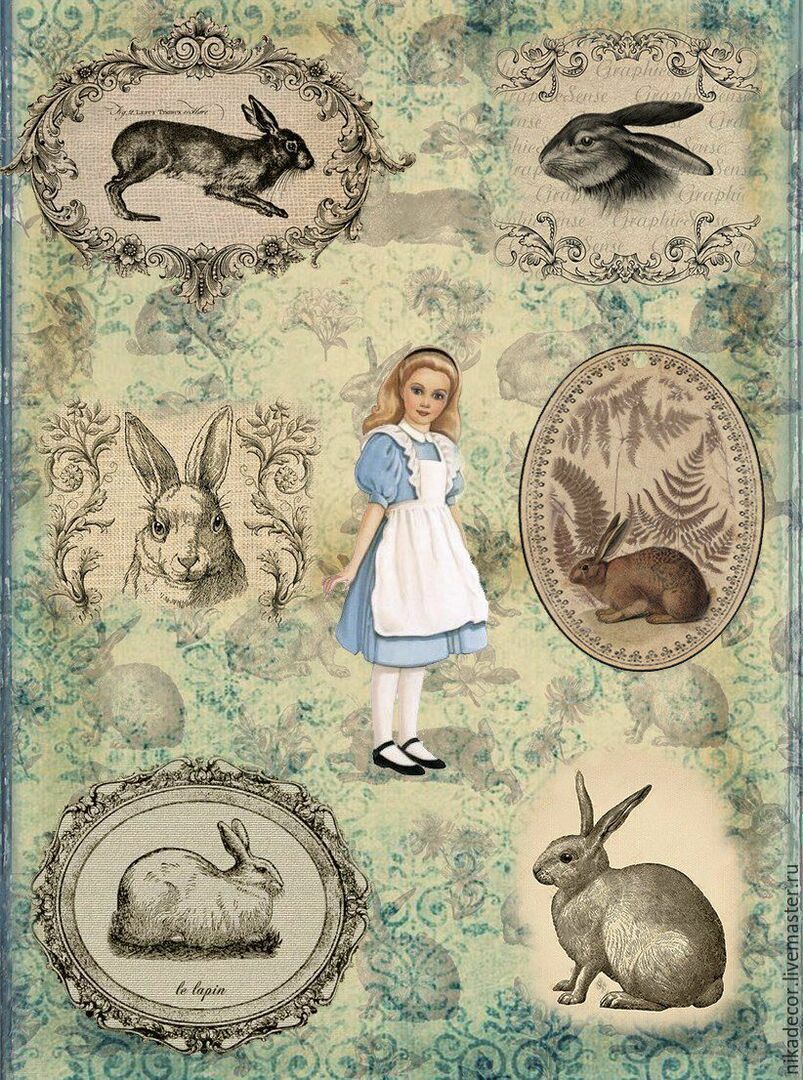 A fairy card for decoupage from rice paper
A fairy card for decoupage from rice paper - Scissors are recommended to use those that are small in size and have rounded ends - this will guarantee that smalldetails will be safely cut out of thin paper
- Brush needs a flat, width is desirable within a centimeter-two - varnish and paint to such tools are applied simply superb. And keep in mind that the larger the workpiece, the bigger the brush
 . Here is the brush - what you need for decoupage
. Here is the brush - what you need for decoupage - Clay - as previously mentioned, it is desirable all the same PVA, although it is possible for the sake of interest to purchase a special adhesive for decoupage
IMPORTANT: Usually, after gluing a picture, the wizards process it with paints and varnish. Sometimes enough and gluing properties of the varnish, but it is better to keep the PVA with you.
- Varnish - and again the flight of fantasy is assured. Matte, glossy, acrylic, with the effect of diamond gloss and craquelure - a choice for every taste. The advantages of lacquers for decoupage are that they do not smell, do not turn yellow with time and, importantly during operation, do not allow the traces of the brush to not surface
- Sandpaper - an indispensable assistant when preparing the surface for work
- Primer is also desirable, as it perfectly level the surface and helps reduce paint costs. Optimal choice - acrylic non-toxic water-based primer
 Without a primer in decoupage, it's difficult to manage.
Without a primer in decoupage, it's difficult to manage. Decoupage for beginners from napkins: master class
The smooth ceramic surface of the plate is what is necessary for beginners in decoupage. It's not recommended to take food from such a plate, , but as an object of decor it is incomparable. It is required to stock up:
1. Actually, the
dish 2. Alcoholic napkin
3. Napkin for decoupage
4. Stationery file
5. Water sprayer
6. Adhesive
7. Acrylic lacquer
8. Acrylic paints
9. Brush
10. Roller
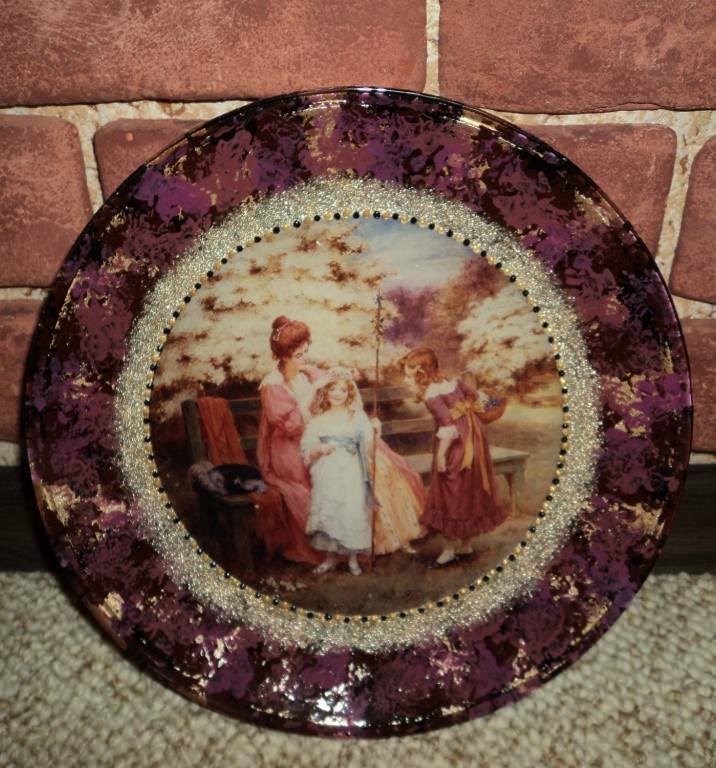 Decorative plate made by the method of decoupage
Decorative plate made by the method of decoupage Let's proceed:
- First of all we take alcohol wipes - they perfectly degrease the plate. After it dries thoroughly, must be applied to the entire PVA surface. And again to leave to dry
- Now it is time to be accepted for a decoupage napkin. It is necessary to carefully separate the first layer with the
pattern from it IMPORTANT: Many beginners mistakenly believe that the drawing after applying the napkin to the surface should look up. In fact, it is applied by the front part to the surface.
- Put the layer on the file so that it does not tear. Then, sprinkle it all with water from the spray gun
- That's it - file can be applied to the surface of the plate
- Next, rolls smooth from the center to the edges. This is necessary, otherwise excess moisture and air will interfere with the normal attachment of the image. However, you can do without a roller - a flat brush will serve as a good alternative to
- . Now the file is removed, and the remnants of moisture are removed ordinary napkin. You can make a varnish or paint, glue the three-dimensional elements of colored napkins Decoupage
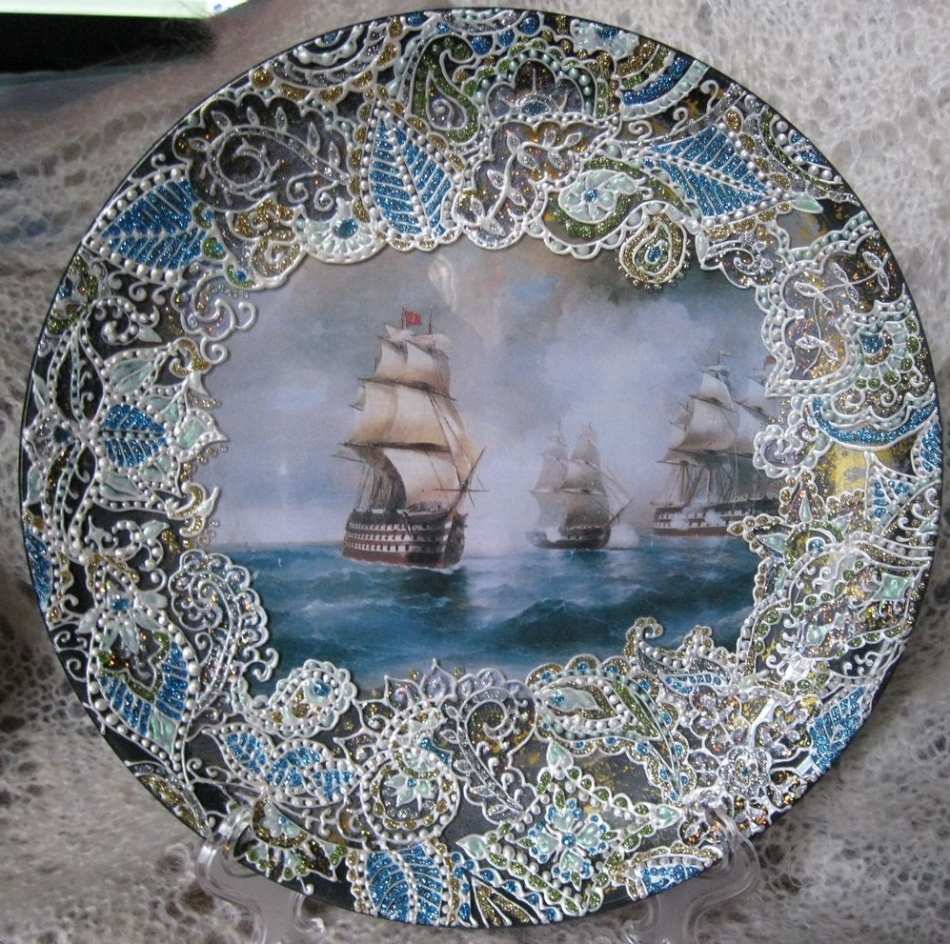 of napkins can be supplemented glued around the edges of the lace
of napkins can be supplemented glued around the edges of the lace  Decoupage napkins can be supplemented with gold paint
Decoupage napkins can be supplemented with gold paint 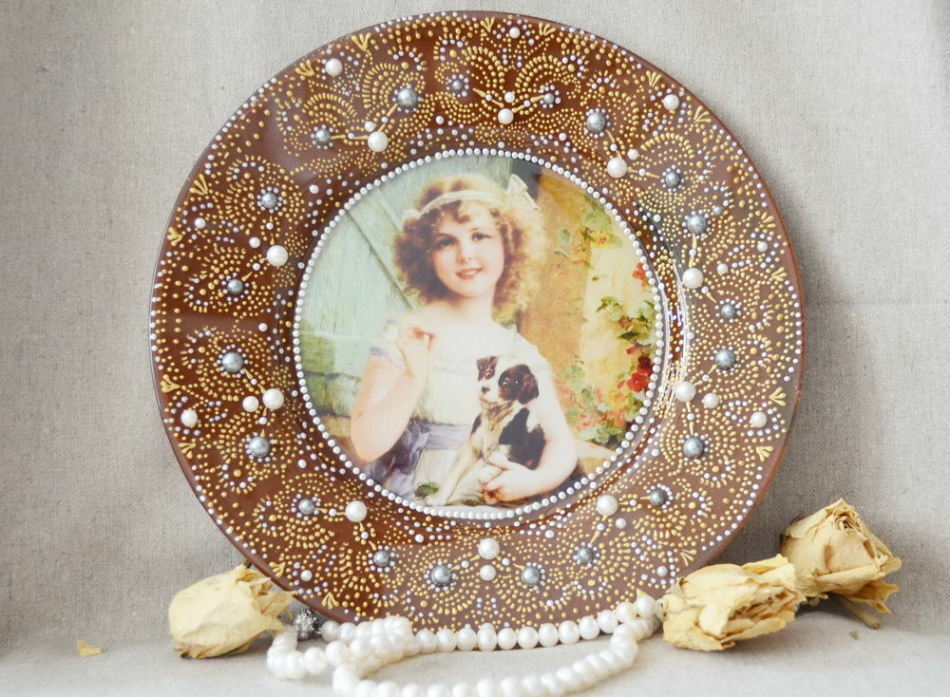 Decoupage plates Victorian Decoupage
Decoupage plates Victorian Decoupage bottles Will be useful for beginners
:
1. Bottle
2. Acrylic paints and varnishes, lacquer special for decoupage
3. Sketch
4. Alcohol
5. Picture for your taste
6. Sponge or sponge. It is desirable to have several pieces - depending on the number of supposed colors
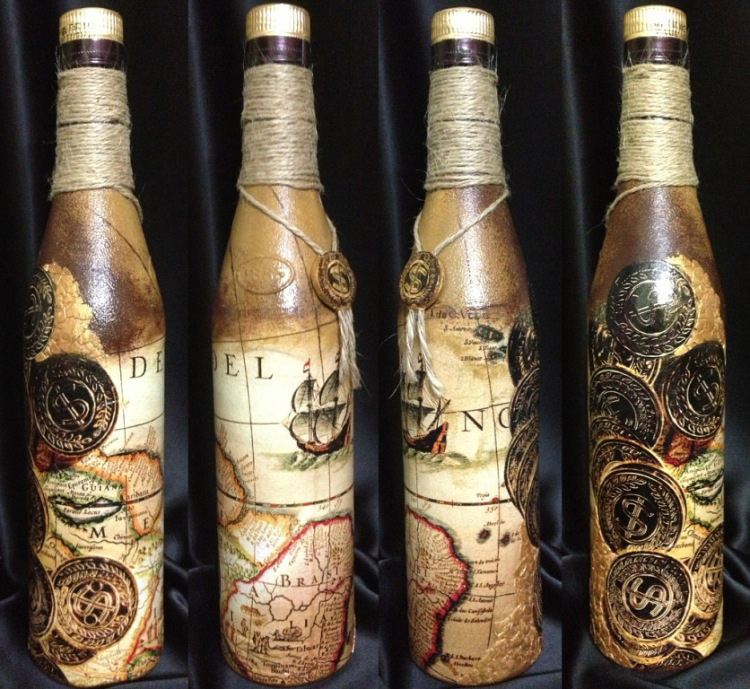 These amazing bottles can be created thanks to decoupage
These amazing bottles can be created thanks to decoupage Let's get to work:
- Alcohol, as in the case with the dish, degrease the surface .The surface dries
- Acrylic paint should be poured into some capacity
IMPORTANT: Apply the paint to the bottle not with a brush, but with a sponge or sponge with a soaking motion.
- Do not miss this item in any way! It is important to wait for the complete drying of each coat of paint. On the bottle it is recommended to put two
- In a deep tank, type water, dip there the sketch of the drawing
- Try on , as far as the size fit sketch for the bottle
- The adhesive is diluted with water from the ratio 2 to 3
- Apply this sticky mass with a brush on the bottle .Choose directions from the center to the edges
- Recommended sponge dipped in the paint, walk around the part of the bottle that is not occupied by the picture. So it turns out to achieve smooth transitions
- Dry as it should a bottle - only after that you can apply a second layer of paint. And let it dry again
- Now you need to coat the product with varnish for durability.
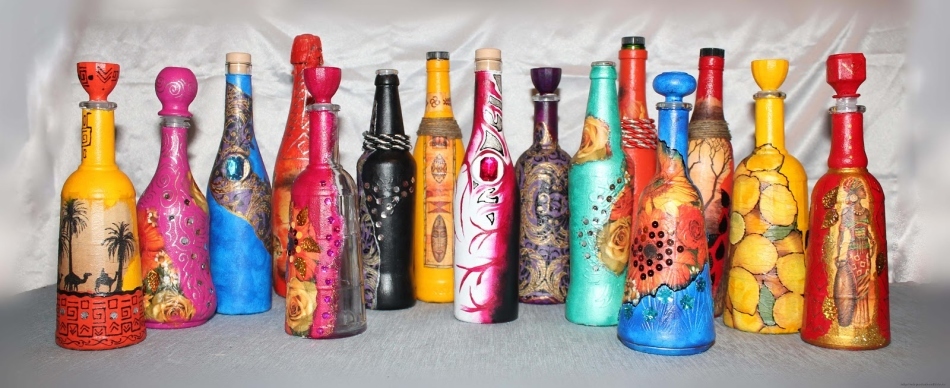 Decoupage of bottles can be anything you like
Decoupage of bottles can be anything you like Decoupage of furniture for beginners
Real vintage furniture is very expensive, but to do this, decoupage is necessary - to simulate the old and decorate the originally faded furniture. Beginners should start with something big - for example, from the chest of drawers . You will need:
1. Actually, chest of drawers
2. Decoupage pictures
3. Acrylic lacquer and paints
IMPORTANT: If you want to create a truly similar to the vintage furniture, do not save on the varnish lacquer. It will give the necessary cracks when drying, which will create the desired visual effect.
4. Bitumen
5. PVA
6. Adhesive
Proceed:
- First of all, unscrew all metal handles - they only interfere with the work. Most dressers are polished - in this case requires sanding and priming
IMPORTANT: If the chest of drawers is not polished, do not waste time on sanding and priming. It's enough just to make a cover with acrylic lacquer.
- Now it's time for golden paint .It is necessary that it dry out well
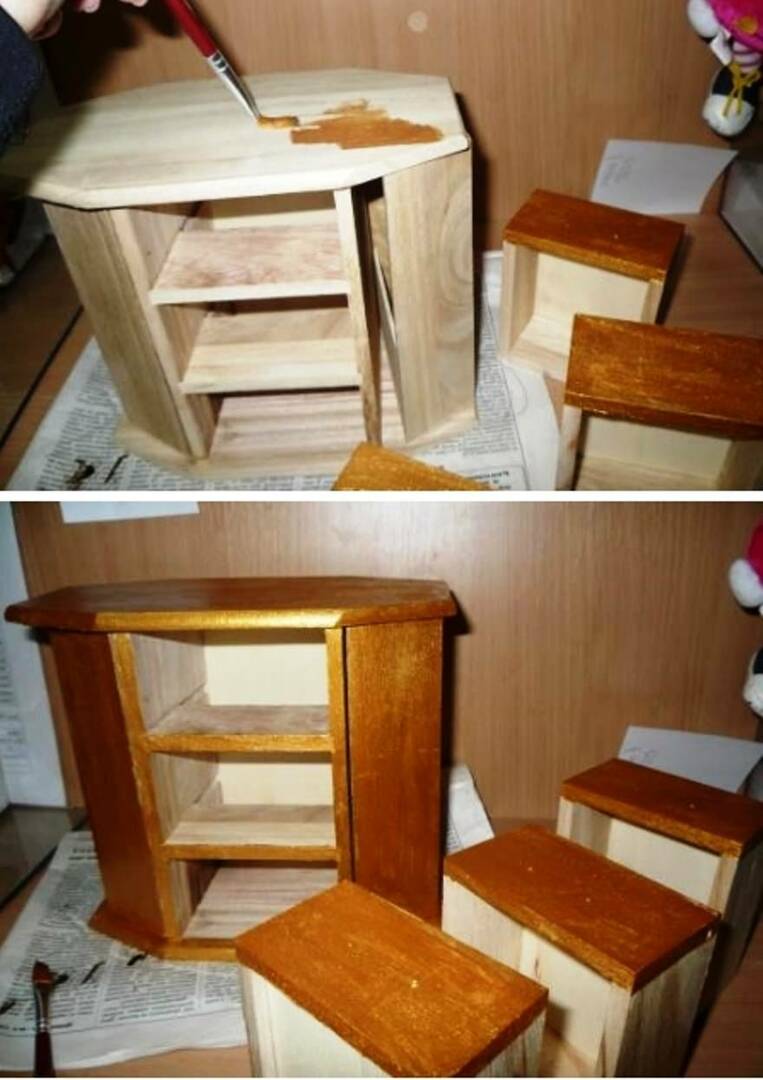 This is how the dresser looks before decoupage and after the preparatory stage
This is how the dresser looks before decoupage and after the preparatory stage - Measure out the edges of a centimeter. Stick tape for an hour so that this tape is made. The same with the boxes
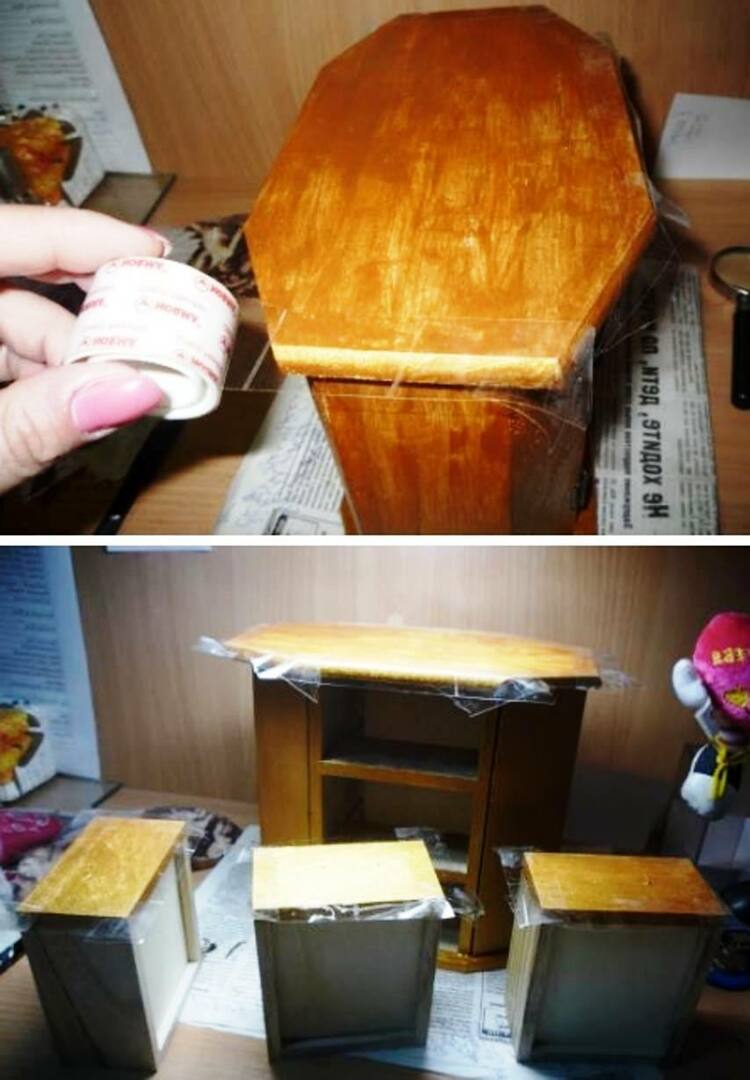 Sticky tape for decoupage
Sticky tape for decoupage - Apply white enamel to the top of the furniture and to the sides of the drawers
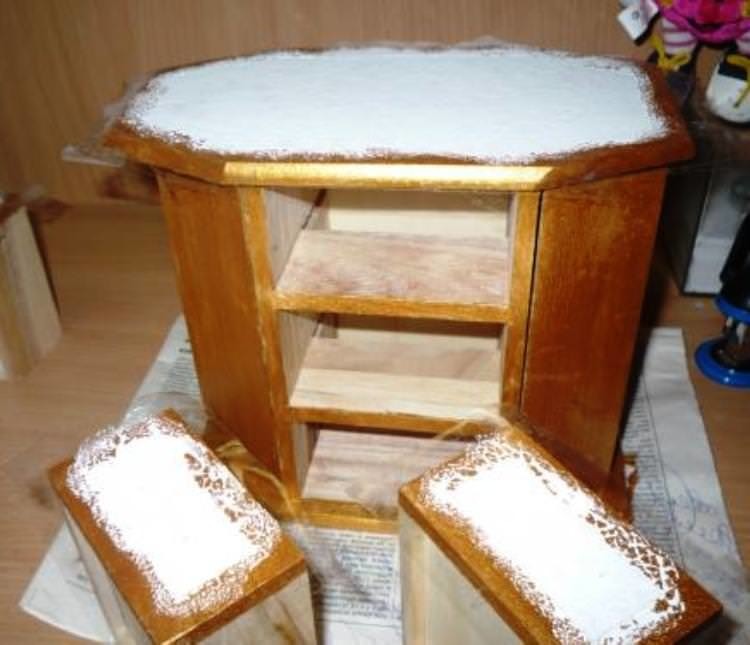 Applying the enamel for decoupage
Applying the enamel for decoupage - It's time for the cracker - put it on the side panels of the
- . When the hour passes after sticking the strips of tape, remove them. The same surface that was previously under the tape, needs to be painted with a brown
paint. IMPORTANT: Apply a sponge with a sponge - this is the best fit for the
- . Finish the part of the painted with the same enamel with sandpaper. It is necessary to try until the golden paint of
- comes out. Cut out the patterns of from the napkins for decoupage, which you want to paste on the furniture. Glue them PVA, level. Wait for the
- adhesive to dry. Coat the furniture with the Crackle again. This time, try to make the crakery lacquer cover the entire surface of the dresser along with the drawings of the
 . This will look like when decoupling a chest of drawers after applying drawings and craquelure
. This will look like when decoupling a chest of drawers after applying drawings and craquelure - Wait for the drying of the varnish varnish. Again, cover it with a surface. Wait for the drying - after that the cracks begin to appear
- Wipe the resulting cracks with bitumen - this is the final stage of the work
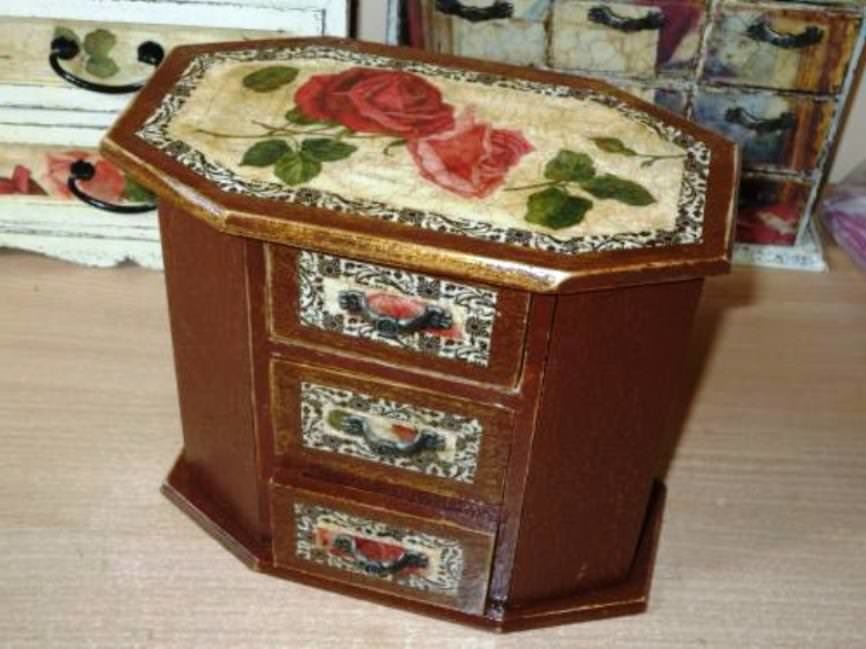 This is how the dresser looks after a simple decoupage for beginners
This is how the dresser looks after a simple decoupage for beginners Decoupage of the glass of beginners step by step
You can try the with a glass jar, chosen for storing coffee .It is common knowledge that cereal or ground coffee will best preserve the flavor if storage is produced in a glass vessel. So, for the thematically decorated jar of you will need:
1. The jar with the lid
2. The wiped napkin
3. The sponge and the clamp for the clerical cases. The latter is desirable if you do not want to get dirty in the paint
4. Acrylic paint white
5. Napkin for decoupage
6. AQUALAK
7. PVA
8. Flat wide brush
9. Toothpick and old toothbrush
10. Real coffeegrains
11. Burnt umber is a paint that will help to make the effect of a small aging
12. Split
13. Bituminous varnish
 This is how a can for coffee in the style of decoupage
This is how a can for coffee in the style of decoupage Get started:
- First of all, of course, you need to degrease Anka alcohol wipe
 degreasing for decoupage
degreasing for decoupage - Now the bank is covered on all sides with white paint. Do not forget about the cover
IMPORTANT: The application of the background is carried out by the impregnating movements of the sponge fixed in the clamp - it is convenient and effective.
 Drawing of white paint for decoupage
Drawing of white paint for decoupage - All this should be good dry
- Now the picture is glued on the PVA.Since the bank is convex, the image is best applied in parts. On the lid also do not forget
 Drawing a picture for decoupage on a jar
Drawing a picture for decoupage on a jar 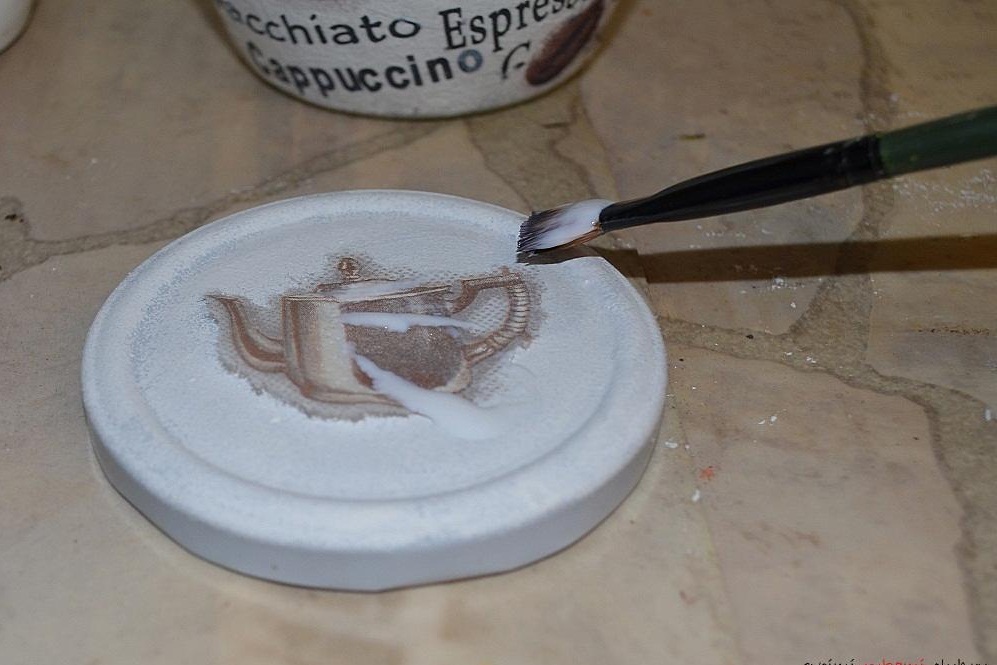 Decoupage of a cover
Decoupage of a cover - And a jar and lid you need to cover with an azawalka
 Cover with an AQUALAKO for decoupage
Cover with an AQUALAKO for decoupage - A lid should be used to decorate with coffee beans. They are glued to the PVA
 Decoration of the lid by the grains in the decoupage process
Decoration of the lid by the grains in the decoupage process - And now we grow old. The toothbrush dips into the umbra and a spray is applied to the jar and cover of the
IMPORTANT: Umbro should be slightly diluted with water beforehand.
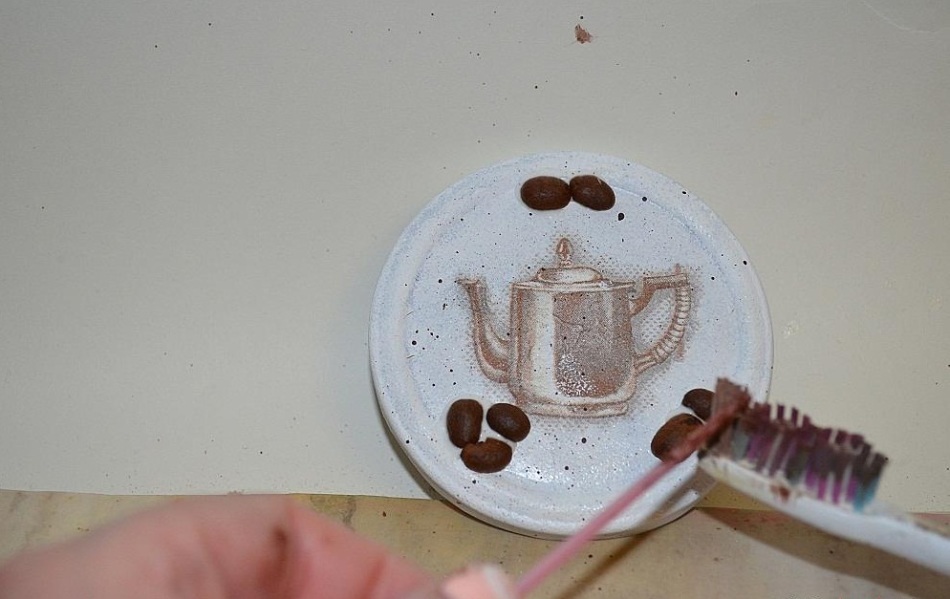 Decoupage of the Umbra Cover
Decoupage of the Umbra Cover 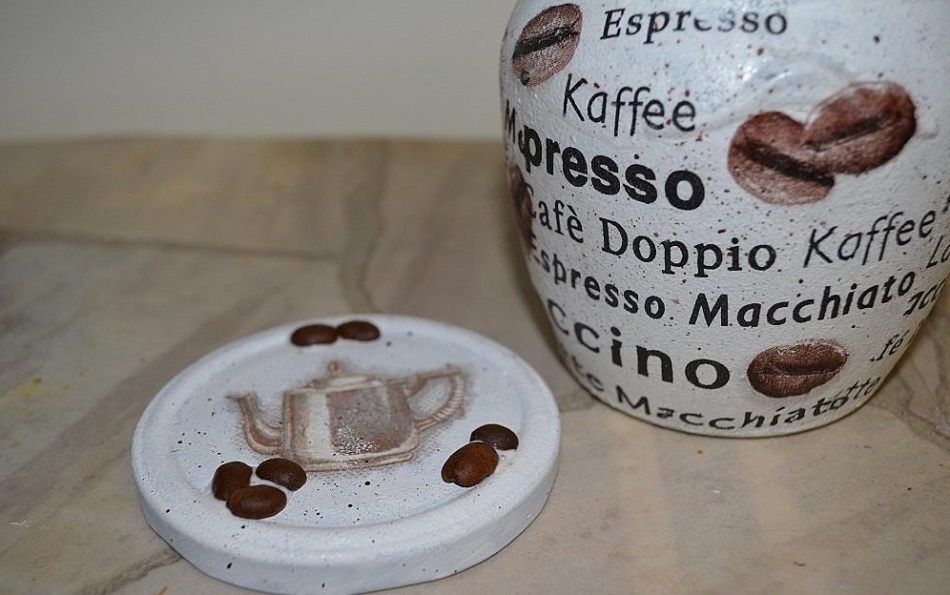 This is how decoupage looks like with aging on the lid and the jar
This is how decoupage looks like with aging on the lid and the jar - Now all this is dried, then it is covered with
- varnish. If you want to add some more aging, should be covered with bituminous varnish of the edge of the cover. Some parts of the can can also be covered with
 Canopy cover and bitumen lacquer cover for decoupage
Canopy cover and bitumen lacquer cover for decoupage - Bind the twine - and the can is ready!
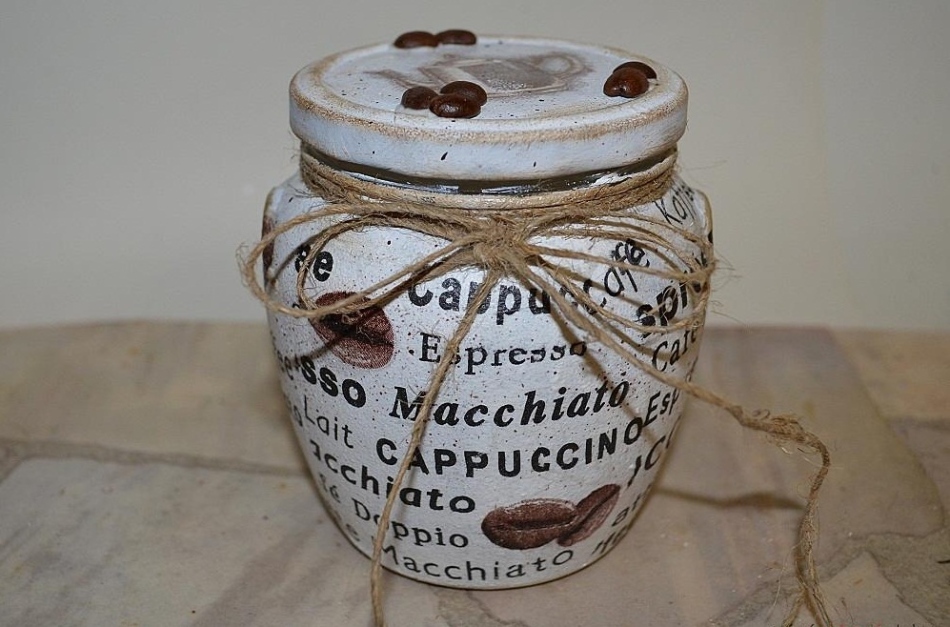 Decoupage is completed by tying twine
Decoupage is completed by tying twine Decoupage for beginners step by step on wood
To start is best with something simple - for example, with a cutting board. This thing will serve to train skills in decoupage, and in everyday life will be used often. So, stock :
1. Board
2. Acrylic paint white and gray colors
3. Decoupage napkin
4. Acrylic lacquer
5. Water in a glass
6. PVA
7. Sponge
8. Brush
9A toothbrush that is not used
10.
candle 11.
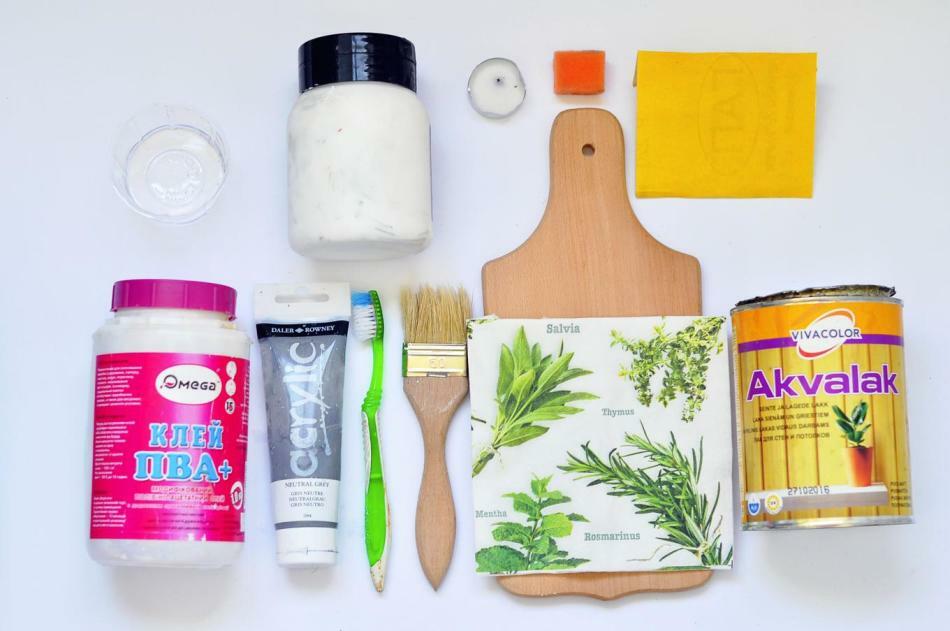 sandpaper This is what you need to decoupage the
sandpaper This is what you need to decoupage the board. Create beauty:
- Apply white dye to the entire outer surface of the board with dents. Application start from the top
boards IMPORTANT: For convenience, the sponge should be cut into 2 or even 3 parts.
 Drawing of white paint for decoupage
Drawing of white paint for decoupage - From the napkin neatly torn off or cut that piece of image , which is necessary
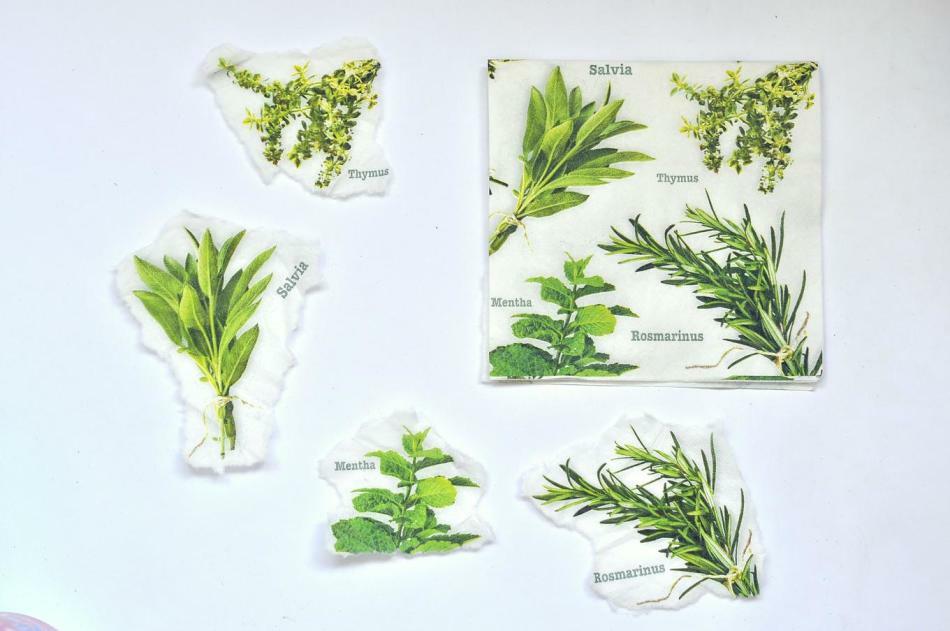 Cut out the desired piece of the picture from the napkin for decoupage
Cut out the desired piece of the picture from the napkin for decoupage - The top layer with the picture is separated from the desired piece of . Do this as neatly as possible
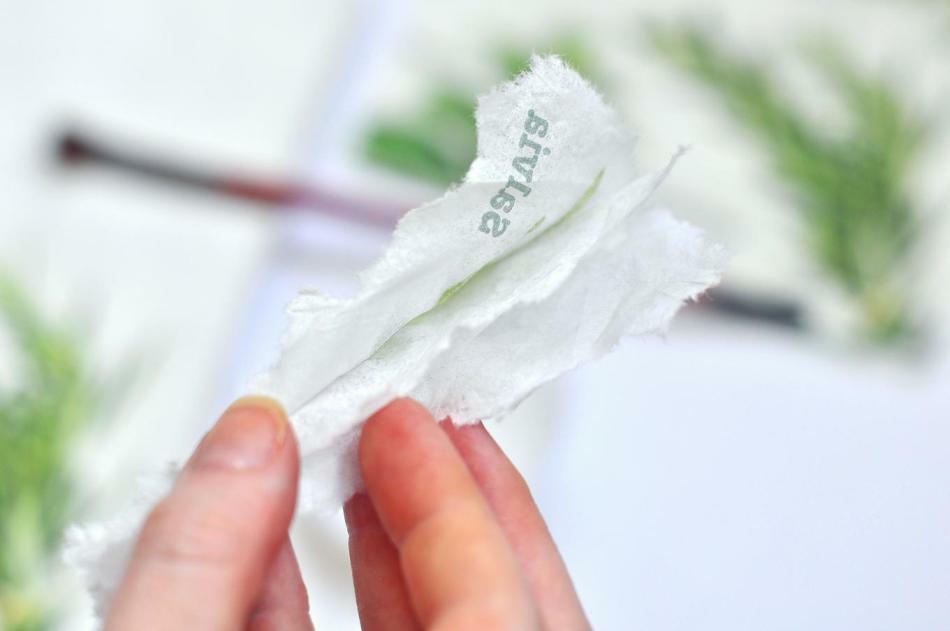 Separate the layer from the napkin for decoupage
Separate the layer from the napkin for decoupage - Add a cup of water with PVA in such a proportion that the liquid consistency of the liquid sour cream eventually emerges. Put the necessary image on the board. Brush the dipping in the cup, and slightly drip the solution into the middle of the drawing
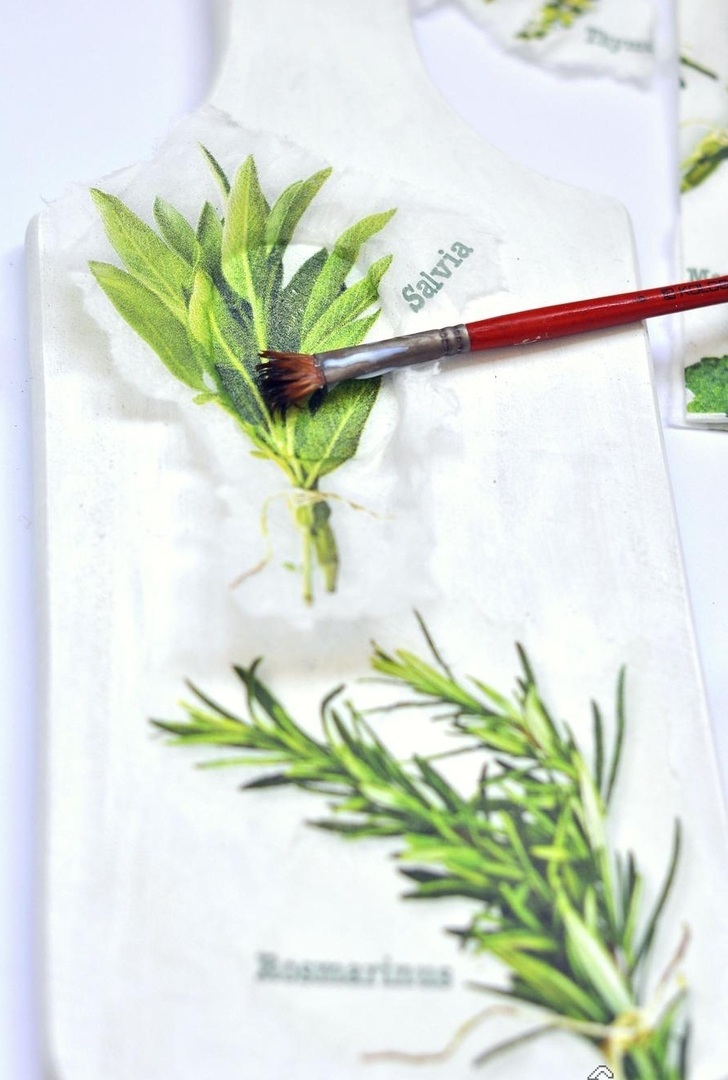 . So the pictures for decoupage should lie on the
. So the pictures for decoupage should lie on the - board. The glue needs to be smeared with a brush according to the drawing .The figure should be carefully smoothed to avoid folds and bubbles effect
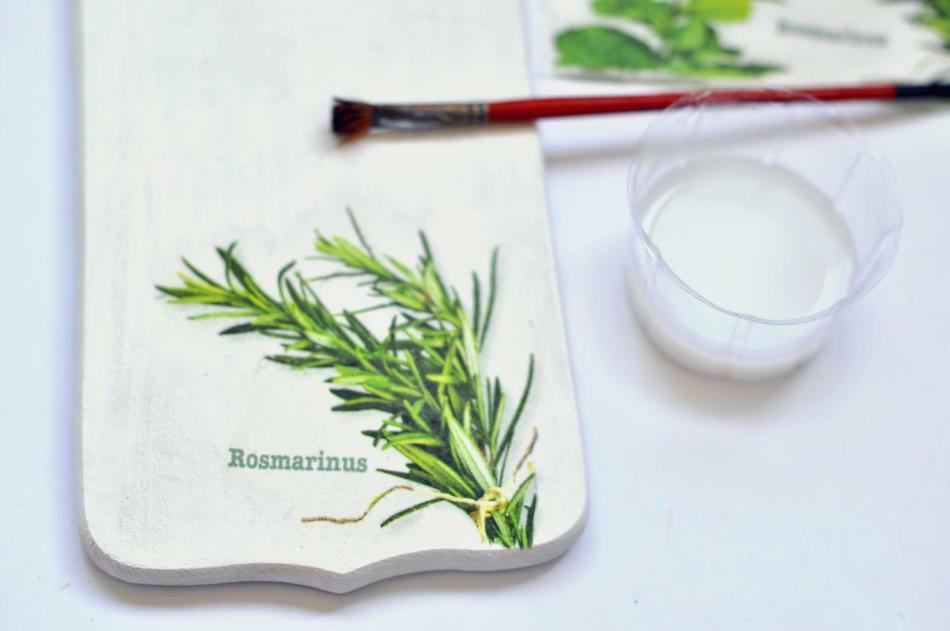 The figure for decoupage should be gently glued to the
The figure for decoupage should be gently glued to the - board. Using the same principle, glue the other
 images. Decoupage pictures are applied using the same principle
images. Decoupage pictures are applied using the same principle - . About the edge of the board you need to rub the candle
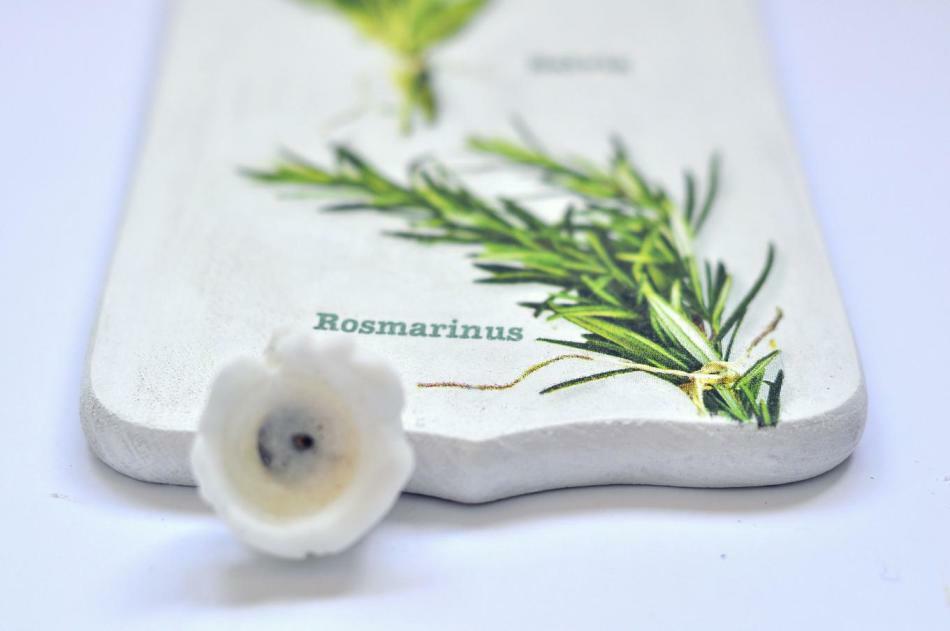 For decoupagethe
For decoupagethe - candle may come in handy. Next, edges should be treated with gray acrylic paint .Apply it with a sponge pressing, but with careful movements
IMPORTANT: Do not overdo the amount of paint - it should be a little bit.
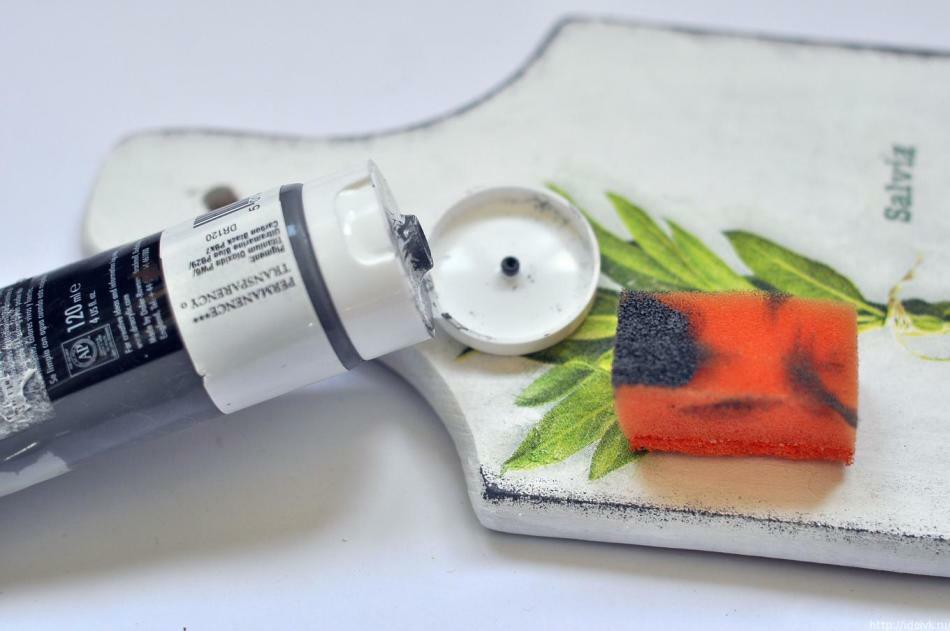 Gray paint is applied to the board for decoupage
Gray paint is applied to the board for decoupage - Gray paint should be applied to the rest of surface, but this time with light rubbing movements
 Gray paint for decoupage is applied to the rest of
Gray paint for decoupage is applied to the rest of - surface. Sand the edges of with sandpaper. Since they were treated with a candle, they will whiten
 Process in the process of decoupling the edges of the board with the
Process in the process of decoupling the edges of the board with the - emery board. Now gray paint is applied in small amount to the toothbrush. Swipe along the bristles towards you - so spray
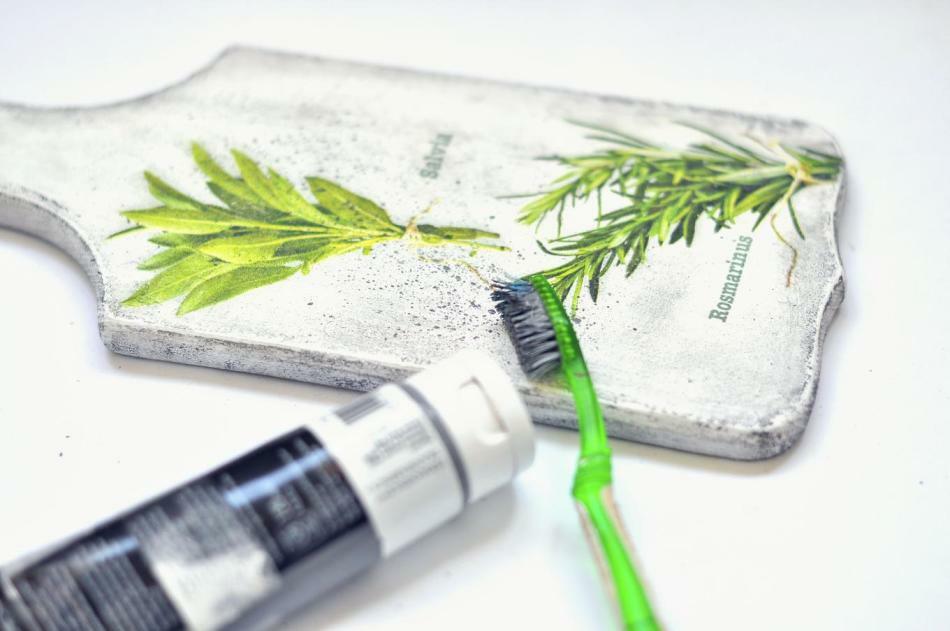 splashes - another trick of decoupage
splashes - another trick of decoupage - And now make such splashes with white paint
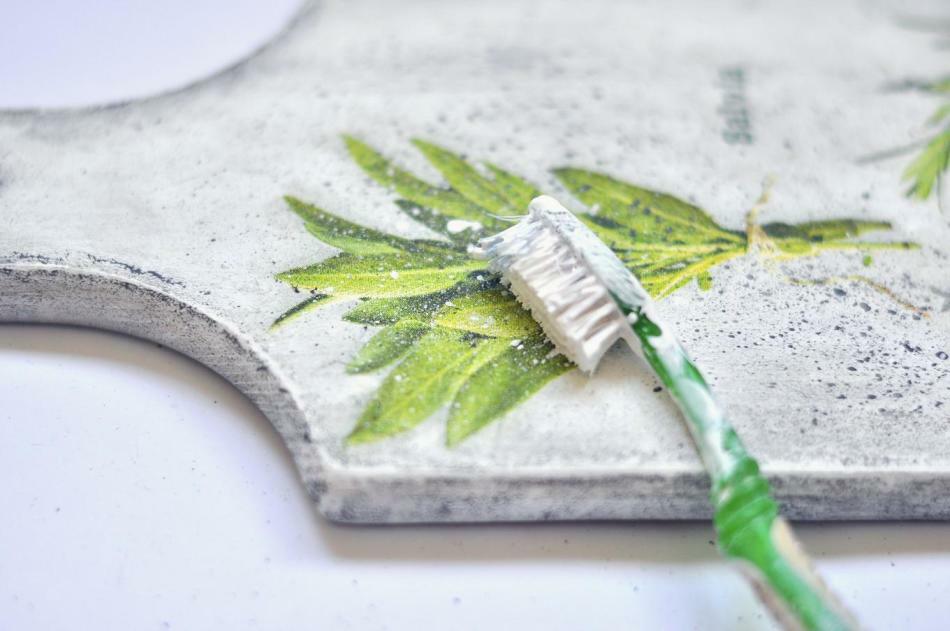 White spray in the process of decoupage too will be useful
White spray in the process of decoupage too will be useful - Final stage - plaque coating with
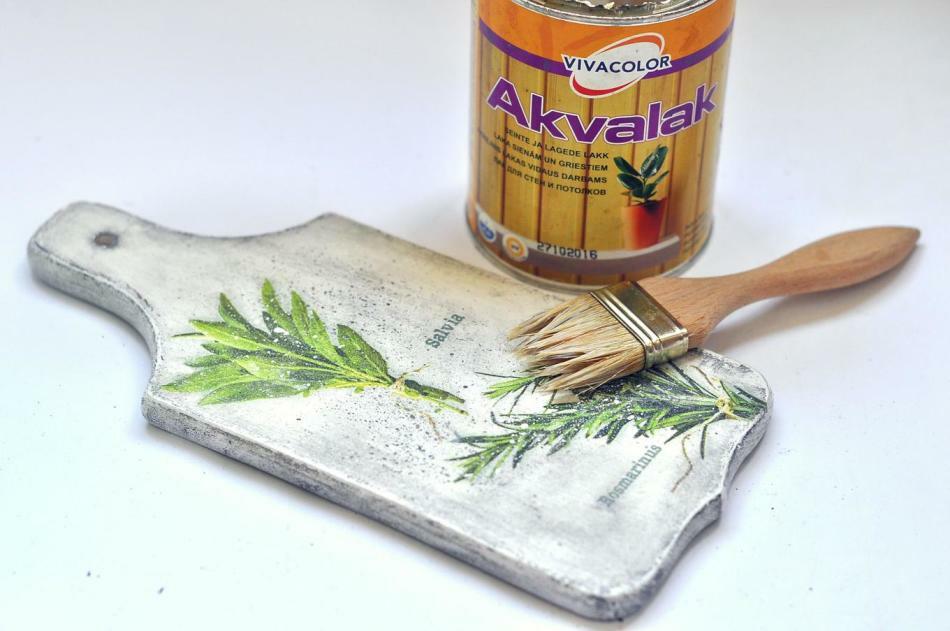 varnish Apply the varnishProvence style board ready
varnish Apply the varnishProvence style board ready Decoupage caskets for beginners
This master class is a kind of foundation, from which you can build off when creating other caskets. Required:
1. Baskets for the casket
2. Flat brushes
IMPORTANT: It is desirable that the brushes were made of non-natural materials
3. Brown acrylic paint
4. Light enamel
5. Toothbrush
6. Candle
7. PVA
9. Rice paper, map for decoupage, napkins
10. Patina. As an analogue, it is permissible to use brown oil paint
11. Acrylic lacquer
12. Sponge
13. Double-sided adhesive tape
14. Various accessories - buttons, laces, etc.
 Cask stock for decoupage
Cask stock for decoupage Now you can proceed:
- Carefully remove all unevennesses. The cleaned surface needs to be covered with acrylic paint of brown color. The box should dry well
- Now with a candle you need to grind all corners and faces
IMPORTANT: Do not remove excess candles by hand - it is better to use a toothbrush for this purpose
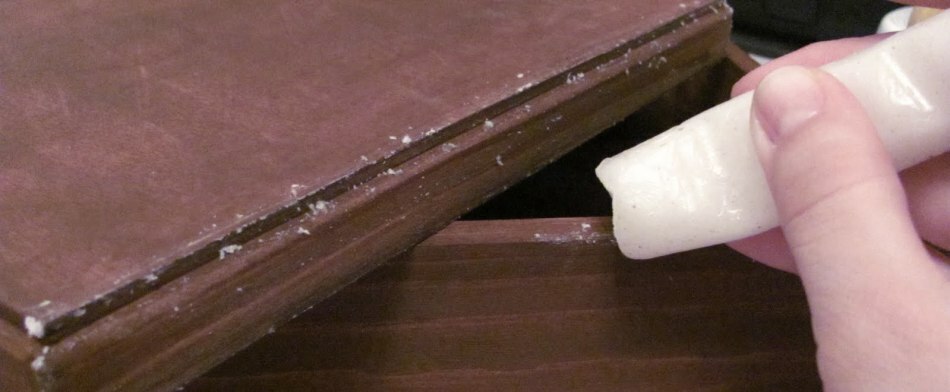 Stripping the faces with a candle during decoupage
Stripping the faces with a candle during decoupage - The surface is covered with white enamel and dried
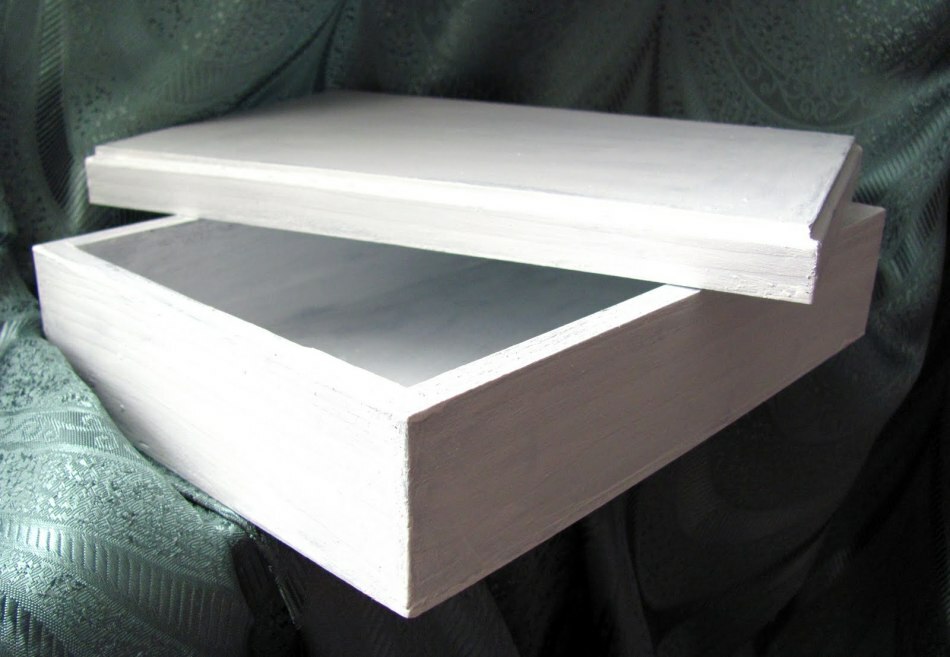 Coating the box with enamelfor decoupage
Coating the box with enamelfor decoupage - Take any thing from metal. Scratch off the paint in the places that were previously rubbed with a candle. Excess paint carefully remove
 Metal object in the process of decoupage is erased paint
Metal object in the process of decoupage is erased paint - Dilute the adhesive in water in a ratio of one to three. With a wide brush, apply a solution to the place of the casket where the image
- will be placed. Attach a picture, and again cover the PVA on top. Move from the center to the edges. At the same time, it is necessary to smooth out all the irregularities
- Remove the excess adhesive with a brush. Leave the workpiece to dry
 The box, pasted with pictures for decoupage, is dried
The box, pasted with pictures for decoupage, is dried - Pre-soak the cards for decoupage in water
- Patina or oil paint need to cover the corners, faces
 The corners and faces of the box in the decoupage should look like
The corners and faces of the box in the decoupage should look like - Now turn the acrylic lacquer .The box needs to be dried afterwards
- The bottom of the box should be pasted with two-sided tape - the fabric
will be attached to it IMPORTANT: Do not forget to wet this cloth in a glutinous solution - this will get rid of the wet threads.
 The casket for decoupage from the inside is covered with double-sided scotch
The casket for decoupage from the inside is covered with double-sided scotch - Items for decor also need a preparatory stage. Lace must be soaked in instant coffee with sugar. Then they are slightly squeezed out and put on the battery. Rinse do not need
 Accessories for decoupage boxes also need to prepare
Accessories for decoupage boxes also need to prepare - It remains to paste the lace, braid and buttons. Desirable for transparent glue
 View of the lid of the casket after decoupage from the top
View of the lid of the casket after decoupage from the top 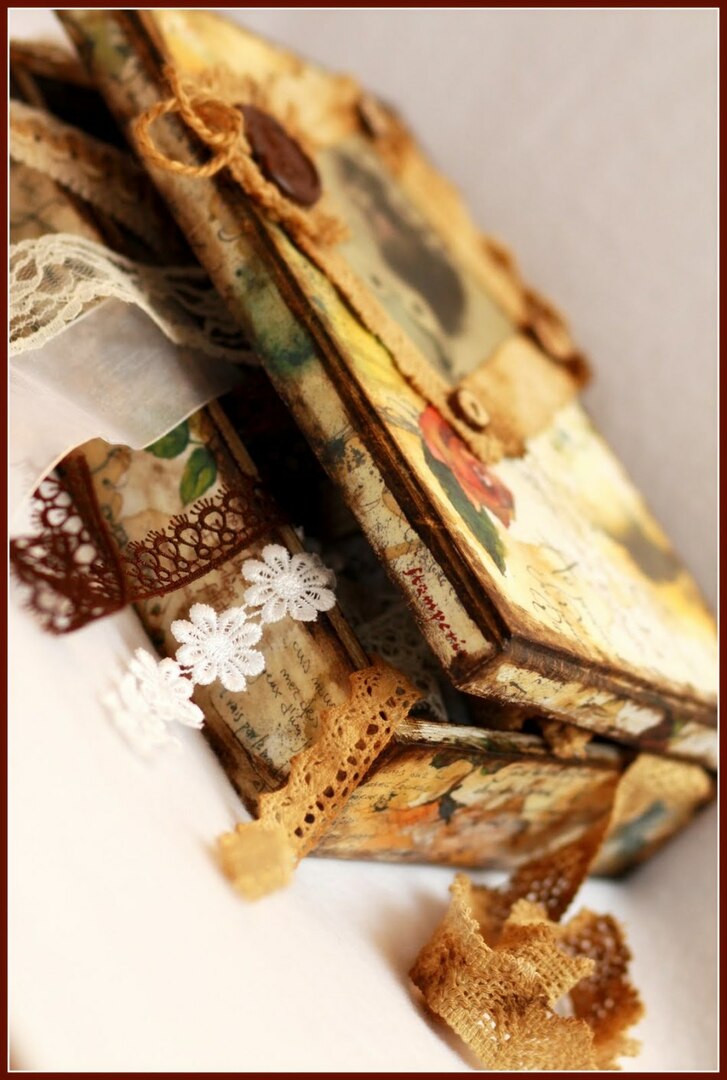 Casket after decoupage from the side
Casket after decoupage from the side  Casket after decoupage from the inside
Casket after decoupage from the inside Decoupage for beginners
Decoupage of hours is great for beginners. Stencils, dials, arrows and other elements of the workpiece for the watch can easily be found in bookstores or in stores for creativity
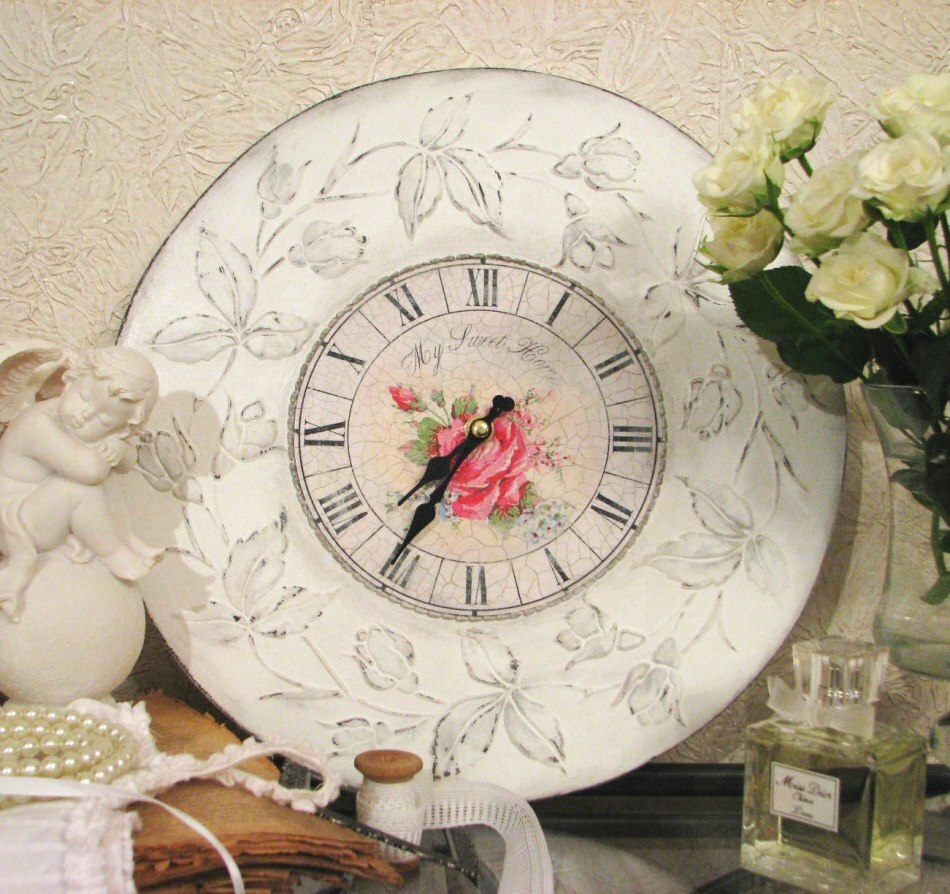 The watches with decoupage can be round
The watches with decoupage can be round  Also the decoupage watch can be square
Also the decoupage watch can be square - So, take the workpiece. You can not worry about where to mount the arrows - in the blanks holes, as a rule, are available. And the recess for the batteries is also
IMPORTANT: However, you need to prepare the future dial. If it is wooden - sand, if plastic - degrease.
 Workpiece for decoupling the clock
Workpiece for decoupling the clock - Now you can start to make out the dial .There are no restrictions at all - if you choose, be guided by interior features and imagination. Even ready-made decoupage sheets are sold in the form of dials
 Decoupage sheets for
Decoupage sheets for - watch Attach a picture of onto the workpiece. Keep in mind that if the paper is rice, you do not need to soak it. Smooth out all the wrinkles
- Allow the workpiece to dry and then varnish. Dry again. And so three times
 Victorian decoupage clock
Victorian decoupage clock 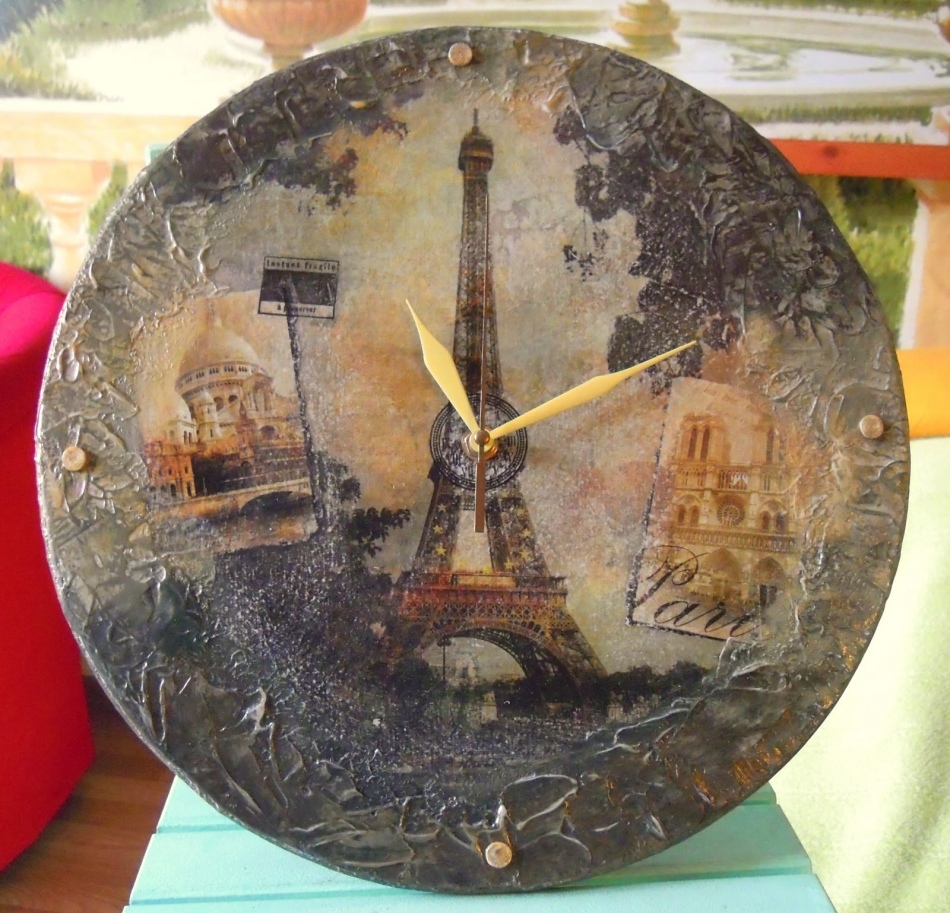 Decoupling watch for connoisseurs of romance Paris
Decoupling watch for connoisseurs of romance Paris  Watch after decoupage in Hollywood style
Watch after decoupage in Hollywood style 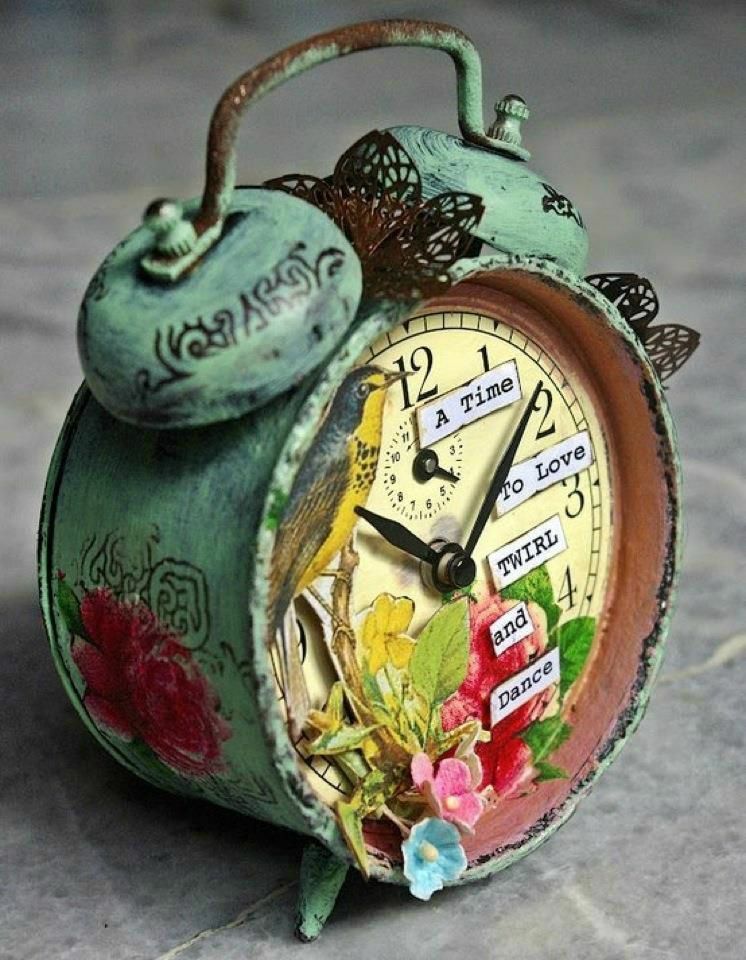 And here's a funny decoupage of the old alarm
And here's a funny decoupage of the old alarm Decoupage of tea houses for beginners
What you need:
1. Wood billet
2. Thin acrylicembossed paste
3. Spatula-mastichin, thanks to which it is convenient to apply primer and remove excess
4. Acrylic paints
5. Rice card
6. Matte varnish in the form of spray
7. Matte acrylic lacquer
8. Gel with 3D effect
9.
glue 10. Stencil for future shingles
We proceed:
- First of all, needs to be primed billet for house
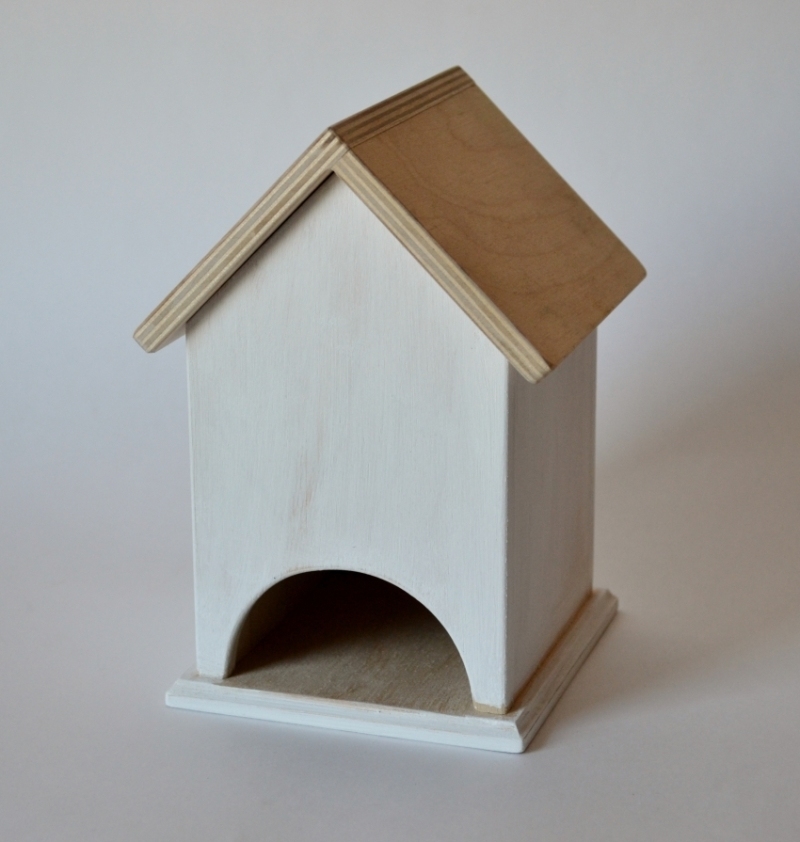 Priming the surface of the house during decoupage
Priming the surface of the house during decoupage - Cut out from the map the required pictures
IMPORTANT: Makestock per centimeter.
- Stick all the images to the right places. However, stick only the middle of the pictures
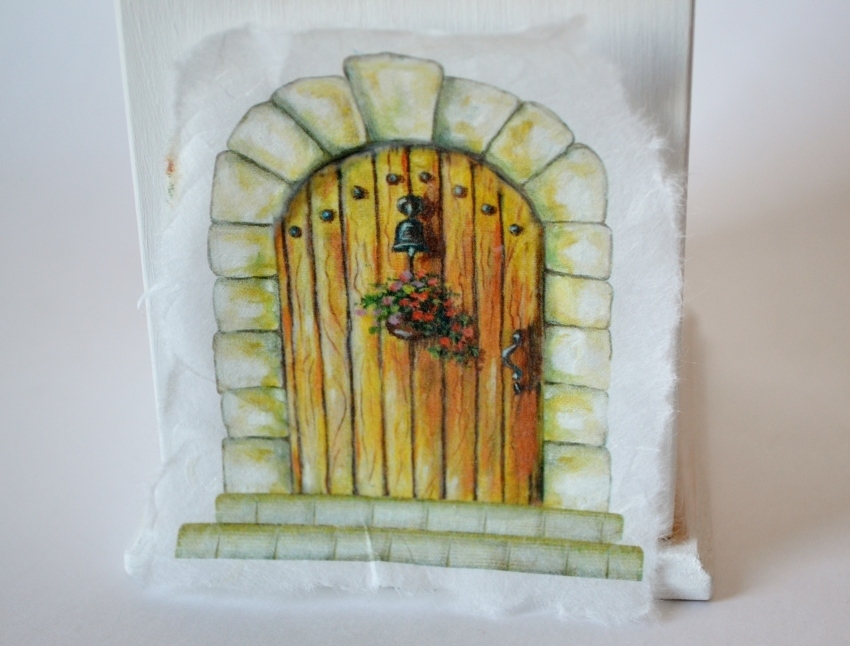 Stick pictures for decoupage to where they should be
Stick pictures for decoupage to where they should be - But for what it is not necessary to paste the entire image at once. Under the free edges you need to apply a palette knife - it's all done for the volume of the house
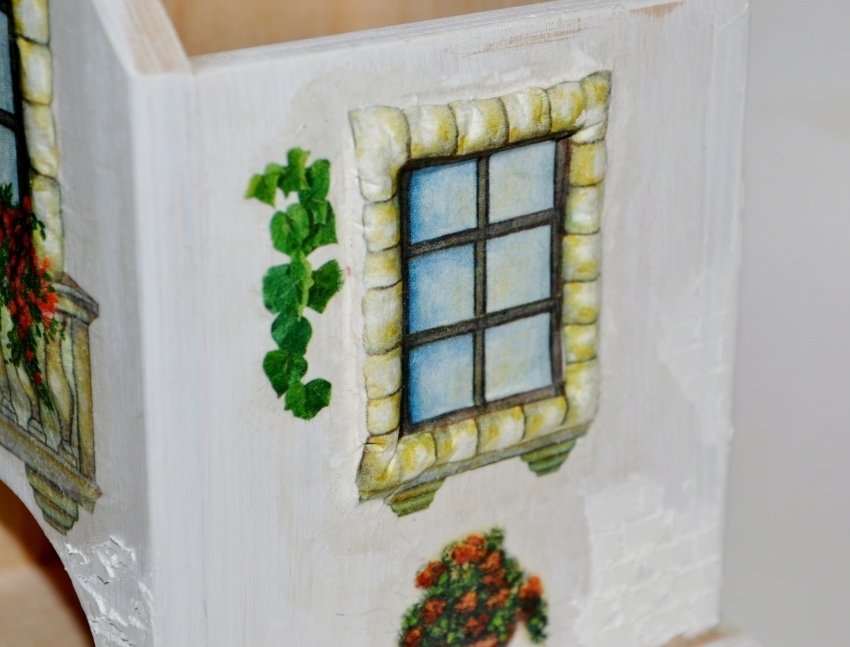 This is a large window is obtained thanks to decoupage
This is a large window is obtained thanks to decoupage - Relief same paste can be painted bricks. The
- toothpick will help. Using the stencil and bulk paste, you need to apply the
- shingles. Mix the colors in advance - can so it turns out that the desired shade is not represented in the finished form.
 . Mixing of paints for the decoupage of the house
. Mixing of paints for the decoupage of the house - . Now begins the painting process of the house
 House paintingin the process of decoupage
House paintingin the process of decoupage 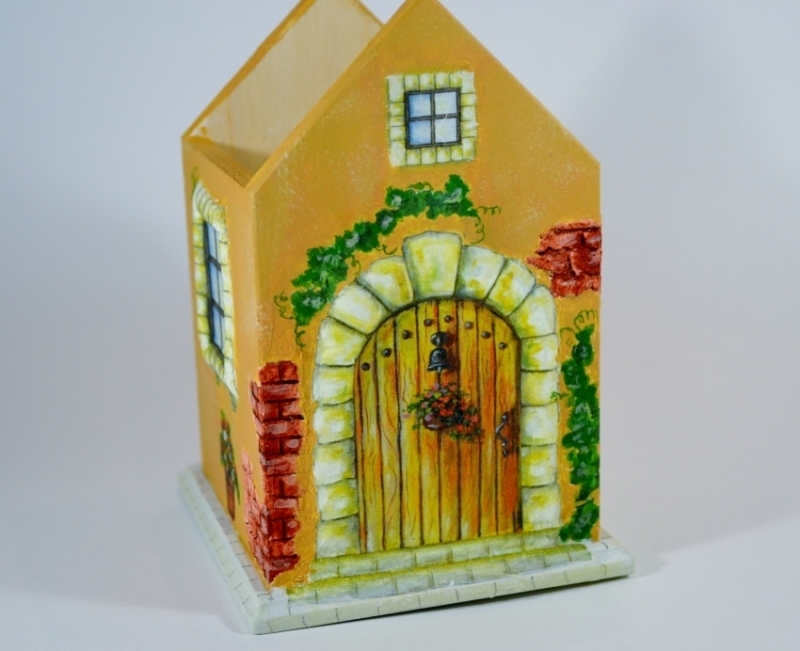 That's how the house is transformed in the process of decoupage
That's how the house is transformed in the process of decoupage - For more similarity do not be afraid to post additional details - lantern, masonry
 Designated masonry and house lantern for decoupage
Designated masonry and house lantern for decoupage - Color lantern and masonry. Add to the credibility of the crack on the walls
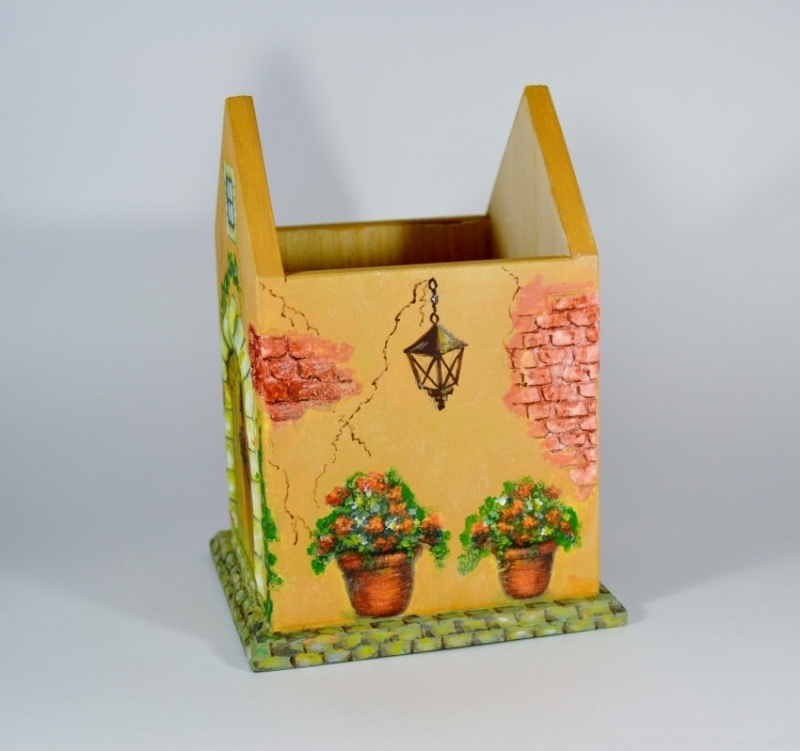 Decoupage can be used to mark cracks on the walls of the house
Decoupage can be used to mark cracks on the walls of the house - Color the roof
 Painting in the process of decoupling the roof
Painting in the process of decoupling the roof IMPORTANT: Do not paint the house inside.
- It is recommended to use the dark umber in order to finish the roof - so it will be brighter than
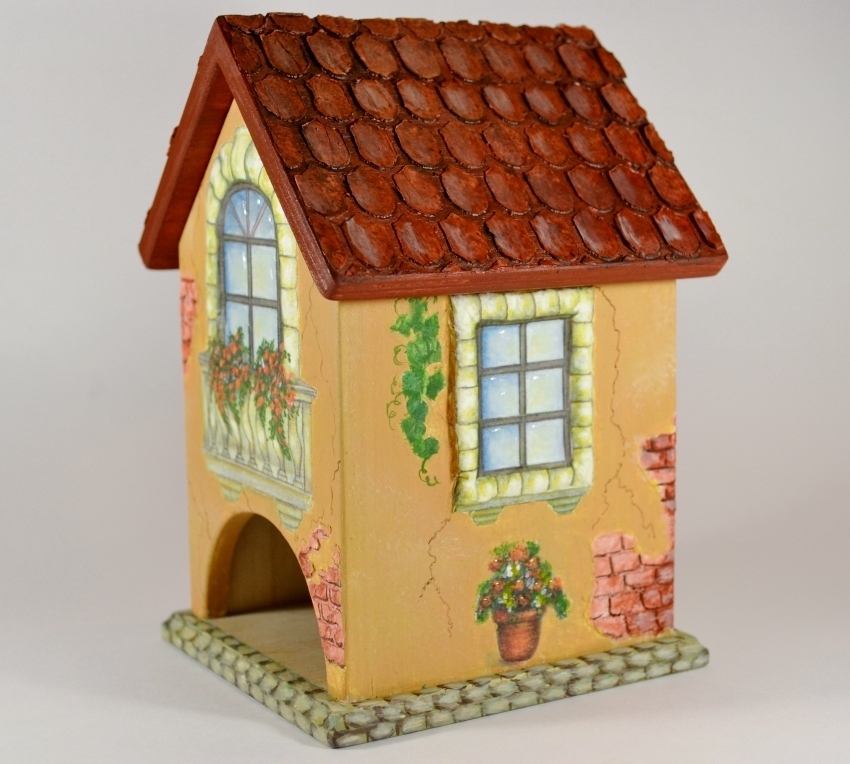 Roof processing in the process of decoupling umber
Roof processing in the process of decoupling umber - Add highlights. And on the lantern and windows - 3D gel
 3D gel on the windows of the decoupage
3D gel on the windows of the decoupage  3D gel on the lantern at the decoupage house
3D gel on the lantern at the decoupage house - Cover the house with matt varnish - and it's ready!
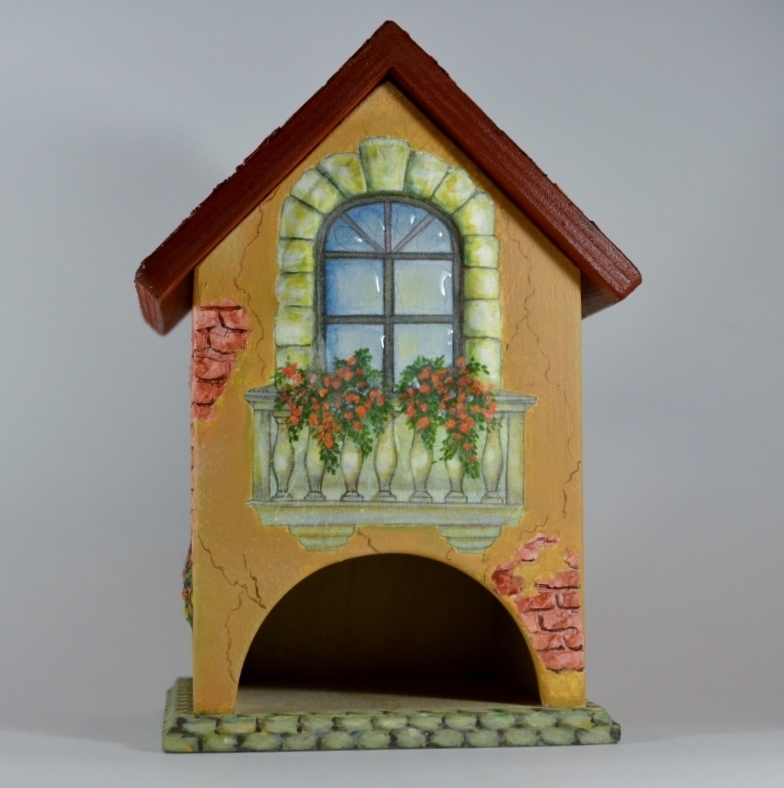 House after decoupage
House after decoupage Many people who like decoupage, it seems that this art is only possible for masters. But the masters are not born, they become! Moreover, many of the techniques are fairly simple to perform, so you should never be afraid to start creativity.
